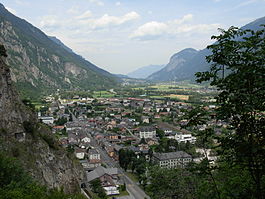Vernayaz
| Vernayaz | |
|---|---|
 |
|
| Coordinates: 46°8′N 7°2′E / 46.133°N 7.033°ECoordinates: 46°8′N 7°2′E / 46.133°N 7.033°E | |
| Country | Switzerland |
| Canton | Valais |
| District | Saint-Maurice |
| Government | |
| • Mayor | Blaise Borgeat |
| Area | |
| • Total | 5.6 km2 (2.2 sq mi) |
| Elevation | 452 m (1,483 ft) |
| Population (Dec 2015) | |
| • Total | 1,886 |
| • Density | 340/km2 (870/sq mi) |
| Demonym(s) | Planain |
| Postal code | 1904 |
| SFOS number | 6219 |
| Localities | Miéville |
| Surrounded by | Dorénaz, Evionnaz, Martigny, Salvan |
| Website |
www SFSO statistics |
Vernayaz is a municipality in the district of Saint-Maurice, in the canton of Valais, Switzerland.
In 1913 the municipality was created when it separated from Salvan.
Vernayaz has an area, as of 2011[update], of 5.7 square kilometers (2.2 sq mi). Of this area, 12.9% is used for agricultural purposes, while 54.9% is forested. Of the rest of the land, 17.3% is settled (buildings or roads) and 14.9% is unproductive land.
The blazon of the municipal coat of arms is Quartered Gules a Cross bottony Argent and Sable a Mullet of Five Or overall a pallet wavy Argent.
Vernayaz has a population (as of December 2015[update]) of 1,886. As of 2008[update], 24.5% of the population are resident foreign nationals. Over the last 10 years (2000–2010 ) the population has changed at a rate of 12.6%. It has changed at a rate of 12.5% due to migration and at a rate of 0.7% due to births and deaths.
Most of the population (as of 2000[update]) speaks French (1,413 or 88.5%) as their first language, Italian is the second most common (48 or 3.0%) and Portuguese is the third (47 or 2.9%). There are 23 people who speak German.
As of 2008[update], the population was 49.3% male and 50.7% female. The population was made up of 646 Swiss men (35.9% of the population) and 241 (13.4%) non-Swiss men. There were 698 Swiss women (38.8%) and 214 (11.9%) non-Swiss women. Of the population in the municipality, 688 or about 43.1% were born in Vernayaz and lived there in 2000. There were 413 or 25.9% who were born in the same canton, while 154 or 9.6% were born somewhere else in Switzerland, and 311 or 19.5% were born outside of Switzerland.
...
Wikipedia



